Facial expression recognition ability and its neuropsychological mechanisms in children with attention deficit and hyperactive disorder.
Q2 Medicine
Zhejiang da xue xue bao. Yi xue ban = Journal of Zhejiang University. Medical sciences
Pub Date : 2024-04-18
DOI:10.3724/zdxbyxb-2023-0390
引用次数: 0
Abstract
Attention deficit and hyperactive disorder (ADHD) is a chronic neurodevelopmental disorder characterized by inattention, hyperactivity-impulsivity, and working memory deficits. Social dysfunction is one of the major challenges faced by children with ADHD. It's found that children with ADHD perform less well than typically developing children on facial expression recognition (FER) tasks. Generally, children with ADHD have some difficulties in FER, while some researches suggest that they have no significant differences in accuracy of specific emotion recognition with typically developing children. The neuropsychological mechanisms underlying these difficulties are as follows: 1. neuroanatomically, compared to typically developing children, children with ADHD show smaller gray matter volume and surface area in the amygdala and medial prefrontal cortex regions, as well as reduced density and volume of axons/cells in certain frontal white matter fiber tracts; 2. neurophysiologically, children with ADHD exhibit increased slow-wave activity in their electroencephalogram, and event-related potential studies reveal abnormalities in emotional regulation and responses to angry faces when facing facial stimuli; 3. psychologically, psychosocial stressors may influence FER abilities in children with ADHD, and sleep deprivation in ADHD children may significantly increase their recognition threshold for negative expressions such as sadness and anger. This article reviews research progress on the FER abilities of children with ADHD over the past three years, analyzing the FER deficit in children with ADHD from three dimensions: neuroanatomy, neurophysiology and psychology, aiming to provide new perspectives for further research and clinical treatment of ADHD.注意力缺陷和多动障碍儿童的面部表情识别能力及其神经心理学机制。
注意力缺陷和多动障碍(ADHD)是一种慢性神经发育障碍,以注意力不集中、多动冲动和工作记忆缺陷为特征。社交障碍是多动症儿童面临的主要挑战之一。研究发现,多动症儿童在面部表情识别(FER)任务中的表现不如发育正常的儿童。一般来说,多动症儿童在面部表情识别任务中会遇到一些困难,但也有研究表明,多动症儿童在特定情绪识别的准确性上与发育正常的儿童没有明显差异。造成这些困难的神经心理学机制如下:1. 在神经解剖学上,与发育正常的儿童相比,多动症儿童的杏仁核和内侧前额叶皮层区域的灰质体积和表面积较小,某些额叶白质纤维束中轴突/细胞的密度和体积也较小;2.神经生理学方面,多动症儿童脑电图中的慢波活动增加,事件相关电位研究显示,多动症儿童在面对面部刺激时,情绪调节和对愤怒面孔的反应出现异常;3.心理学方面,社会心理压力可能会影响多动症儿童的FER能力,多动症儿童睡眠不足可能会显著提高他们对悲伤和愤怒等负面表情的识别阈值。本文回顾了近三年来关于ADHD儿童FER能力的研究进展,从神经解剖学、神经生理学和心理学三个维度分析了ADHD儿童的FER缺陷,旨在为ADHD的进一步研究和临床治疗提供新的视角。
本文章由计算机程序翻译,如有差异,请以英文原文为准。
求助全文
约1分钟内获得全文
求助全文
来源期刊

Zhejiang da xue xue bao. Yi xue ban = Journal of Zhejiang University. Medical sciences
Medicine-Medicine (all)
CiteScore
3.80
自引率
0.00%
发文量
67
 求助内容:
求助内容: 应助结果提醒方式:
应助结果提醒方式:


